Aphrodisiac Activity of Nutraceuticals
Abstract
The name aphrodisiac is taken from Aphrodite who is penned as the Greek goddess of love, beauty and sex in an ancient folk tale. Dating from a remote period humans strive hard to improve their sexual powers but modern lifestyle and other environmental factors have resulted in many sexual dysfunctions. Current treatment strategies which had lead to unsuccessful results and high cost made man to search for alternative medicine or to include nutraceuticals in their food diet which improves aphrodisiac properties. There are hundreds of medicinal plants that can improve aphrodisiac activity and also there are herbs that have a nutraceutical value other than medicinal properties which improve aphrodisiac activity. There are many numbers of nutritional factors as well as phytochemical factors present in fruits and vegetables other than calories and fats which are helpful in providing nutritional health and to cure diseases. This review divulges about some nutraceutical food plants which are helpful for relieving sexual dysfunction or to improve sexual function.
Keywords
Aphrodisiac, Nutraceuticals, Sexual dysfunction, Phytochemicals
Introduction
From time immemorial the search for remedy for sexual dysfunction or to enhance sexual function has been a haunting situation throughout the history. Finally the search for the ultimate aphrodisiac drug has not stopped with thousands and hundreds of natural or artificial substances tried. As stated by Greek poet Hesoid the goddess of love, beauty, pleasure and sex Aphrodite was born when Cronus made Uranus eunuch and he threw the pudenda in sea which formed a sea form (aphros) arose Aphrodite (Shamloul, 2010). Aphrodisiac is defined as food, drink or an agent which induces sexual desire. There are many aphrodisiac substances varied from foods, plants, synthetic chemicals and spices. Aphrodisiac can be classified based on the effect and mode of action, based on effect includes psychological and physiological for example hallucinating aphrodisiac possess psychological effect which improves sexual desire and mode of action includes those that increase potency, libido and pleasure (Ali, Ansari, & Kotta, 2013).
In ancient history aphrodisiac has depicted as Vajikaranas meaning vaji- horse and karanta- making (Singh, Ali, Gupta, Semwal, & Jeyabalan, 2013). Sexual performance is one of the main factors in improving quality of life. Sexual health can be said as one of the major factor that grant to self satisfaction and a happy family. The concept of sexual performance differ from individual to individual whereas to define a good sexual performance and poor sexual performance vary based on concept of sexual health individually. Smoking, alcohol consumption, stress, fatigue, age factor and body image can also be factors for sexual dysfunction (Eseyin et al., 2018). Sexual dysfunction is a serious problem which occurs in 10- 52 % of men and 25- 63 % of women (Al-Bekairi, Shah, & Qureshi, 1990). This problem has increased widely due to cytological factors and age related problem (Patel, Kumar, Prasad, & Hemalatha, 2011). Erectile dysfunction, ejaculation dysfunction, hypogonadism and impotence are major sexual dysfunction. Other than drugs or medicines, management of sexual dysfunction includes counselling of patients by psychiatrist or psychologist, which can also cause changes in such problems (Sahoo, Sahoo, Sarangi, Senapati, & Nandy, 2014). The use of aphrodisiac drug leads to serious problems such as altering levels of certain neurotransmitters or specific hormones in the body mainly by altering testosterone in the body (Patel et al., 2011).
Vajikarnas is an ayurvedic aphrodisiac or tonics that rear or giving direct support for the reproductive tissues (Sahoo et al., 2014). There are natural aphrodisiac such as plant aphrodisiac and non plant aphrodisiac (Shamloul, 2010) . There are food products or plant nutraceuticals which improve sexual function or which prevents sexual dysfunction. Nutraceuticals are food or food product which act mainly as a supplement in diet and assist in treating or prevention of diseases. These are not involved in the category of medicinal plants but will give any effect in treating diseases where it acts its main role as a supplement.
In this review, we will discuss about the research done on aphrodisiac activity of nutraceutical plants which includes fruits and vegetables and examine whether the use of any of these improves sexual function or desire.
Mechanism
The control and regulation of sexual desire is done by central nervous system which admix olfactory, tactile and mental stimuli (Nimesh, Ashwlayan, & Barman, 2019) . The aphrodisiac substance acts differently in human body includes androgen based and nitric oxide based mechanism of action. Nitric oxide is a neurotransmitter which helps in relaxation of penile vasculature and the smooth muscle trabecular which helps in penile erection. Relaxation of this smooth muscle leads to increased blood flow to penis and will reduce the vascular resistance. By compressing the subtunical venules the out flow is decreased. The reduced out flow and the increased inflow results in penile erection and engorgement. SecondarysexualSecondary sexual organs such as vas deferens, seminal vesicle, prostate, epididymis and penis is grown by testosterone an androgen. The conversion of this androgen hormone into estradiol increases sexual function (Eseyin et al., 2018).There are three different stages of aphrodisiac potential those are
First: sexual performance or libido is increased by nutritional value or wellbeing of the people by such aphrodisiac products
Second: second group is aphrodisiac which affects physiologically than psychologically, this increases blood flow and eventually increases sexual activity
Third: Third group are compounds which crosses the blood brain barrier and acts psychopharmacologically which stimulate arousal (Nimesh et al., 2019).
Some Nutraceutical plants with Aphrodisiac potential
Many Nutraceutical which are included in the daily diet has also proven to possess aphrodisiac activity which acts against sexual dysfunction and also improves sexual performance
Allium sativum (Garlic) (Amaryllidaceae)

Aqueous extract of garlic bulbs (Figure 1) was treated to Swiss albino mice aged of 6-7 weeks, in which 40 animals were divided into 2 groups and treated with control and sample. The extract is mixed with drinking water and is given to mice in 100mg/kg body weight for a period of 3 months. Weekly observation of animals was carried out throughout the treatment and observed a symbolic change in male animals such as weight of seminal vesicles and epididymides had increased whereas the control treated group showed a massive increase in body weight (Al-Bekairi et al., 1990).
Fresh bulbs of Allium sativum was extracted with petroleum ether and was tested in male Wistar albino rats to observe the sexual behaviour and sperm count. A group of 4 each containing 6 animals were selected randomly for the study, normal group received CMC suspension, standard group received Sildenafil citrate (5mg/kg), 2 groups received pet. Ether extract of garlic (100mg/kg) (200mg/kg) for 14 days. Sexual behaviour tests and sperm count was conducted. Behavioural tests showed a symbolic change whereas sperm count showed a slight increase when compared to control treated group (Warange, Saravanan, Praveen, & Emdormirymbai, 2019).
Aloe barbadensis (Aloevera) (Asphodelaceae)
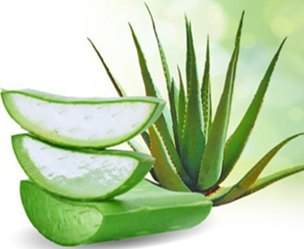
Aloe barbadensis (Figure 2) root extract was tested for aphrodisiac potential and acute toxicity effects. Male and female Wistar rats of weight 140-260 g were taken for the study. A group had given control (water), B, C and D group had treated with different concentrations of root extract such as 100mg/kg, 200mg/kg and 400mg/kg and the last group is administered with standard (Sildenafil citrate 5mg/kg). Animals were tested for mating behavioural study, and serum testosterone determination. The results showed that the mounting frequency and intromission frequency increased on day 1 and day 14and at 100mg/kg dose the testosterone concentration had increased and at 200mg/kg dose a significant decrease in testosterone concentration was observed (Erhabor & Idu, 2017).
Phoenix dactylifera (Dates) (Arecaceae)
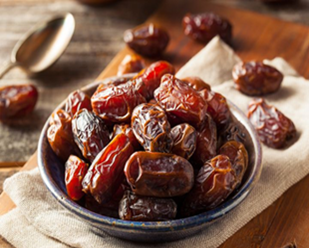
Aqueous extract of pollen grains of Phoenix dactylifera(Figure 3) had prepared and was tested in Wistar albino rats. 60 male and 60 female rats of 280-320 g were selected. Group A which contained 10 animals received saline mixed with dimethyl sulphate and the remaining 5 groups received pollen grains extract as 35, 75, 105, 140 and 350 mg/kg. The male animals were then tested for behavioural characters such as ejaculation latency and frequency, intromission frequency and latency and mounting one hour after administration of extract by mating with the female rats. All the behavioural characters had increased in extract treated group whereas maximum effect was observed for 140mg/kg. Aqueous Phoenixdactylfera had enhanced hormone such as testosterone and estradiol (Ali et al., 2013).
Zea mays (Purple corn) (Poaceae)
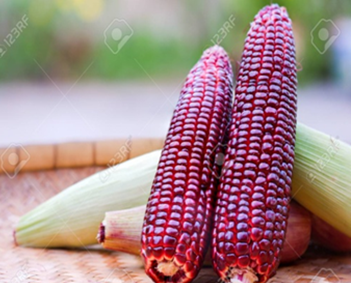
The kernals of purple corn (Figure 4) was extracted with water and was used for the invivo study. The aphrodisiac activity was tested as three series of experiment includes. For the first series male Wistar rats the aqueous extract was given orally at 25, 50 and 75mg/kg and the sexual behaviour data is evaluated and observed that the intromission latency has statistically reduced and at high dose the latency of ejaculation had decreased. The second series received single intravenous injection of extract at the same concentration and then examined for fictive ejaculation model and all the test doses were seem to activate the genital motor pattern of ejaculation in male rats. Third series received the same concentrations of extract which checked the ambulatory behaviour but none of the doses showed the effect (Carro-Juárez, Rodríguez-Santiago, Franco, & Hueletl-Soto, 2017).
Punica granatum (Pomegranate) (Lythraceae)
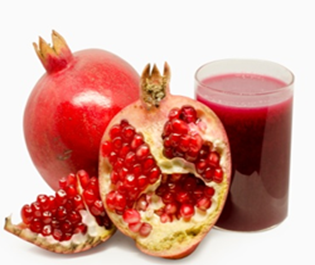
Pomegranate fruit juice (Figure 5) was administered to Wistar albino rats at 500, 1000, 1500mg/kg daily once. The oral administration of this extract showed an increase in sexual activity of male albino rats. There was no significant variation in Mounting and intromission frequency, mounting and intromission latency, post ejaculation and ejaculation latency. There was no noticeable difference in potency when compared to standard and extract. The testosterone levels showed a variable difference when compared to control, extract and standard (Katana, Maina, Orenge, Kirui, & Muriuki, 2019).
Allium cepa (Onion) (Amaryllidaceae)
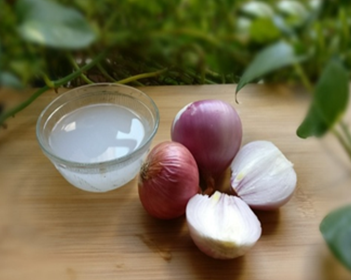
Onion juice extract (Figure 6) was tested for copulatory behaviour in male Albino rats one group with sexual dysfunction induced by paroxetine and other group of sexually potantpotent rats. On testing the copulatory behaviour on sexually potent rats it has noticed that there was a reduction in mount frequency (MF), mount latency (ML), intromission latency (IL), ejaculation latency (EL) when compared to control and there observed an increase in copulatory efficacy. When tested on paroxetine induced dysfunction the mount frequency period of standard was shorter when compared to control and testosterone levels had increased (Allouh, Daradka, Barbarawi, & Mustafa, 2014).
Musa acuminate (Banana) (Musaceae)
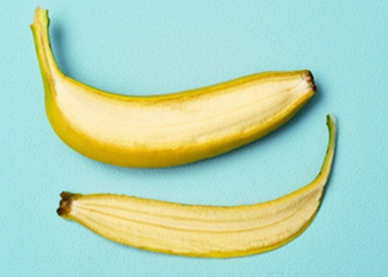
The aqueous banana peel (Figure 7) extract when administered to rats at the dose of 200mg/kg and 400 mg/kg for 28 days. When compared to control treated the yellow and green banana peel extract showed increase in mount latency, intromission latency and ejaculation latency and it showed a reduction in mount frequency, intromission frequency, ejaculation frequency and ijaculatory interval. The water extract of banana peel decreased testosterone levels and increased estrogen levels (Zakaria, Abdel-Raheem, Al-Busadah, & El-Nazawi1, 2017).
Apium graveolens (Celery) (Apiaceae)
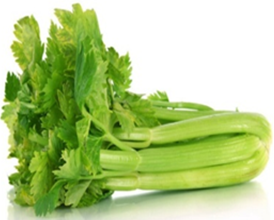
The water extract of celery leaves (Figure 8) was administered to rats for 30 days at a concentration of 100 mg/kg and 200 mg/kg. The scrotum and testis were removed for the further study and it was observed that was a noticeable increase in the diameter of seminiferous tubules, volume of testis and the number of primary spermatocytes, spermatozoa and spermatogonia whereas at high doses the number of spermatides had increased (Hardani, Afzalzadeh, Amirzargar, & Mansouri, 2015).
Coffea arabica (Peaberry coffee) (Rubiaceae)
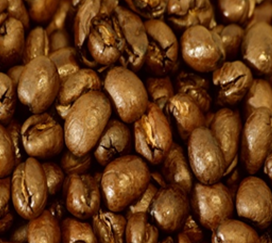
Powdered pea berry coffee beans (Figure 9) had showed almost similar effect of kissing vagina that of Methyl testosterone and more effect that of regular coffee beans and the testosterone levels were average when compared to standard and normal coffee bean when administered to rats of musculus strain at a dose of 0.10/25g (Wahono, 2016).
Camellia sinensis (Tea) (Theaceae)
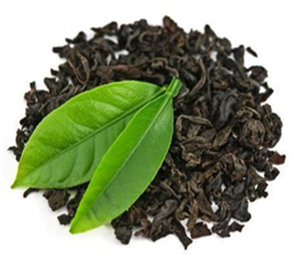
Effect of black tea (Figure 10) brewon low dose, mid dose and high dose on Wistar rats significantly prolonged the ejaculation latency and at low dose it increased testosterone levels in serum. The most appreciable effect of black tea brew on ejaculation latency was noticed on low dose which showed an increase by 34%. Penile erection showed a negative effect at this low dose (Ratnasooriya & Fernando, 2008).
Citrullus lanatus (Watermelon) (Cucurbitaceae)
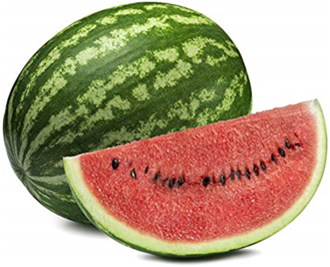
Flesh of watermelon (Figure 11) was dried and extracted with ethanol and was tested in Wistar rats. Animals were administered with different doses of watermelon extract such as 100mg/kg, 500mg/kg and 1000mg/kg b. w. and was observed for 22 days. The results showed that the mount frequency, intromission frequency and ejaculation latency1 (ejaculation latency in first series) has increased for the highest concentration of dose mount latency, intromission latency, ejaculation latency and ejaculation interval was increased at the lowest concentration. There was a negative results for the increase in body weight and reproductive organ weight (Munglue, Kupittayanant, & Kupittayanant, 2014) .
Fragaria ananassa (Strawberry) (Rosaceae)
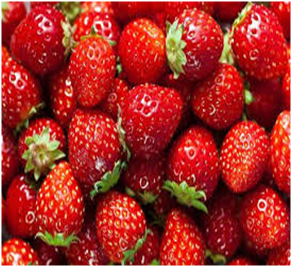
A clinical trial was conducted for 40 females of a median age 21 and were divided into two groups, one group of 19 was informed that strawberries are having aphrodisiac effect and the other group of 21 was told that it is an anti- aphrodisiac fruit. Each participants are allowed to eat different parts of strawberries (Figure 12) then they were tested for valence and arousal rating using International Affective picture system (IAPS) and a new set of pictures. The results showed that there was no noticeable increase of arousal rating for erotic or sexual pictures for the group which has informed that strawberries are having aphrodisiac activity when compared to the other group (Bermeitinger, Feldkötter, Hildebrand, Schmieder, & Sellner, 2012).
Trigonellafoenum- graecum (Fenugreek) (Fabaceae)
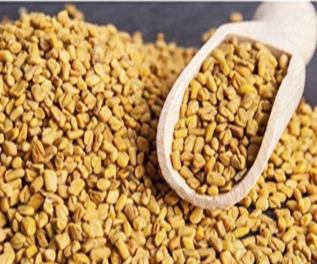
In this study aphrodisiac activity of aqueous extract of fenugreek seeds(Figure 13) was evaluated in diabetic induced Wistar Albino rats weighing between 150- 200g. Each group of animals which contained 6 each had administered orally with plant extract as diabetic animals treated with standard drug (4mg/kg), diabetic animals treated with Trigonellafoenum- graecum aqueous extract (0.87g/kg and 1.74g/kg) and were observed for 42 days. The results revealed that mount latency and intermission latency had reduced and the mount frequency, intromission frequency and ejaculation frequency had increased (Gupta, Ahuja, Kabra, & Soni, 2015).
Moringa oleifera (Drumstick) (Moringaceae)
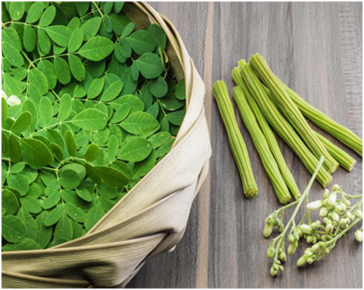
Methanolic extract of seeds of Moringa oleifera (Figure 14) was taken for the invivo study on healthy and diabetic induced rats. Groups of rats containing healthy and diabetic induced male rats were administered with two different concentrations of Moringa oleifera seeds extract (45mg/kg and 90mg/kg) for 21 days and the other group with the standard drug for 7 days. From the study it is evident that there was an in increase in mount and intromission frequency, ejaculation latency, mount and intromission latency and ejaculatory interval in healthy rats and the extract was inactive for diabetic induced rats (Goswami et al., 2016).
Effect of hydro- ethanolic extract of Drumstick leaves (Figure 14) at 10, 50 and 250mg/kg for 7 days on Wistar rats undoubtedly increased themountingthe mounting numbers and intromission numbers at a single dose (10mg/kg) in which they were subjected to immobilization stress and showed a decrease in mounting latency at 50mg/kg. Phosphodiesterase type- 5 activity on penis and serum corticosterone levels had increased on extract treated group at 10mg/kg (Prabsattroo et al., 2015).
Aqueous extract of seeds of Moringa oleifera at doses 100, 200 and 500 mg/kg orally for 21 days were given to rats and the activities such as libido and mating behaviour were studied. It has shown that the water extract improves mount and intromission frequency and ejaculation latency and it reduces mount and intromission latency and ejaculatory interval. The extract then observed to increase sperm count and libido. It has proven that the water extract of Moringa oleifera has a great potential to act against sexual dysfunction and improves sexual function (Zade, Dabhadkar, Vaibhaothakare, & Pare, 2013).
Water, ethanol and chloroform extract of Moringa oleifera seeds were used to evaluated aphrodisiac activity on male Albino rats. The 3 different extracts were administered to rats at 100, 200 and 500 mg/kg for 21 days and the parameters such as libido and mating behaviour was studied. The results proved that the water, ethanol and chloroform extract at the 3 different concentrations increased mount frequency, intromission frequency and ejaculation latency and it tends to reduce mount latency, intromission latency and ejaculation interval and there was a increase in libido with no acute toxicity (Zade et al., 2013).
Cucurbita pepo (Pumpkin) (Cucurbitaceae)
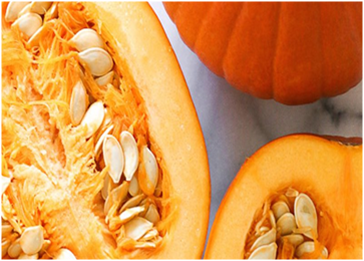
Ethanolic extract of Cucurbita pepo seeds (Figure 15) were tested in Wistar Albino rats at 200mg/kg b. w for sexual behaviour, organ weight, motility and sperm count and serum testosterone levels. The activity of pumpkin seeds at single dose in comparison with control proved that mount latency and intromission latency was less for C. pepo and mount frequency, intromission frequency, ejaculation latency and copulatory efficiency (%) was more when compared to control. At the 14th day of study it was showed that mount and intromission latency was reduced more than the single dose and mount and intromission frequency and copulatory efficiency was increased more than the single dose when compared with the control. At day 28 there was no much variation when compared to day 14 (Sewani-Rusike, Iputo, Ndebia, Gondwe, & Kamadyaapa, 2015).
Zingiber officinale (Ginger) (Zingiberaceae)
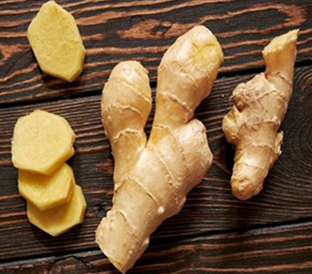
Grinded rhizomes of ginger (Figure 16) dissolved in water was administered to rats at 5.6mg/100g dose for 42 days. Histological observations had done on sections of testis tissue and kidney tissue and they noticed that after 2 weeks of extract administration there occurred a sperm cell degeneration and at the 4th week haemorrhagic congestion and degeneration of sperm cell whereas the same condition occurred at the end of 6 week (Ajanwachuku, Achukwu, Omorodion, Iyare, & E, 2018).
Artocarpus heterophyllus (Jackfruit) (Moraceae)
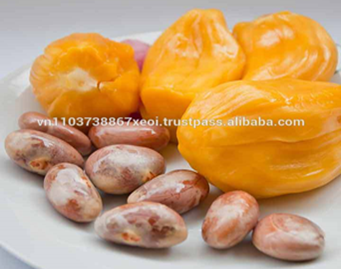
Jackfruit seed (Figure 17) suspensions was administered to Albino rats orally at 500mg/kg and were observed 2 hours after treatment and 6 hours after treatment. Number of intromission and mount latency, ejaculation latency and intercopulatory interval had increased when compared to vehicle and the reduction was noted on copulatory efficiency. This study revealed that the seeds of plant Artocarpus heterophyllus showed positive effect on sexual function and fertility in male rats and it has proven that seed suspension causes sexual arousal, performance and vigour (Ratnasooriya & Jayakody, 2002).
Lepidium meyenii (Maca) (Brassicaceae)
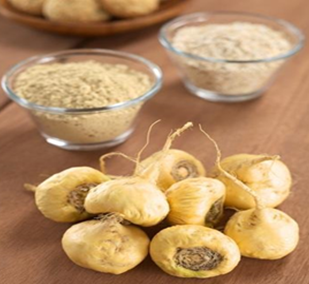
A clinical trial was done on Maca Gelatinizada for 12 weeks to test the hypothesis which has proposed that Lepidium meyenii has no effect on serum hormone levels which was a placebo controlled, double blinded, randomized parallel trial. Men of age 21- 56 were selected for the study and the hormones such as LH, FSH, prolactine, 17-alpha hydroxyprogesterone, 17-beta estradiol and testosterone was tested before study. The clinical trials started by giving1500mg and 3000mg of Maca Gelatinizada and the hormones were tested again at 2, 4, 8 and 12 weeks interval and is has proven that there was no effect for Maca on serum hormone levels (Gonzales et al., 2003).
A double blinded placebo controlled clinical trial was done for evaluating the effect of maca root (Figure 18) on antidepressant induced sexual dysfunction. 45 female patients were selected and the root powder was given at 3g/day and they were observed for Arizona Sexual Experience Scale (ASES) and SexualFunctioningQuestionnaire which doesn’t showed any significant difference and for menopausal women sexual functions were increased when compared to placebo (Dording et al., 2015).
Cocos nucifera (Coconut) (Arecaceae)
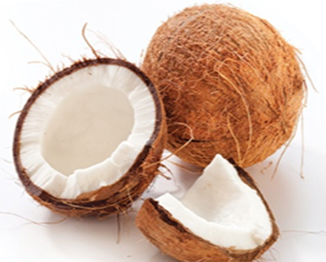
Hydroalcoholic extract of Cocos nucifera(Figure 19) was tested for infertility induced by ceric sulphate in male Wistar rats. Animals were treated with normal saline, ceric sulphate and normal saline, ceric sulphate and 200mg/kg of extract and ceric sulphate and 400mg/kg of extract which showed an increase in mount frequency and intromission frequency and the parameters such as mount latency, intromission latency, ejaculation latency and ejaculatory interval were decreased. The testosterone levels in serum and cauda epididymal tissue were increased in extract treated group (Prakash et al., 2015).
Hylocereus datus (Dragon fruit) (Cactaceae)

Ethanolic extract of dragon fruit (Figure 20) were investigated on Sprague- Dawley rats at a dose of 500mg/kg and found that total testosterone levels in serum has increased when compared with control. Spermatozoa counts, sperm viability, primary spermatocyte counts and spermatide counts was highest for white pitaya fruit extract treated group (Kanedi, 2016).
|
Sl. no |
Plant name |
Common name |
Family |
Part used |
|---|---|---|---|---|
|
1 |
Asparagus officinalis |
Garden asparagus |
Asparagaceae |
Young shoots |
|
2 |
Capsicum annuum |
Chilli pepper |
Solanaceae |
Fruit |
|
3 |
Ficus carica |
Fig |
Moraceae |
Fruit |
|
4 |
Malus domestica |
Apple |
Rosaceae |
Fruit |
|
5 |
Pinus pinea |
Pine nuts |
Pinaceae |
Seeds |
|
6 |
Saffron crocus |
Saffron |
Iridaceae |
Flower |
|
7 |
Persea americana |
Avocado |
Lauraceae |
Fruit |
|
8 |
Juglans cinerea |
Walnuts |
Juglandaceae |
Seed |
|
9 |
Vanilla planifolia |
Vanilla |
Orchidaceae |
Fruit |
|
10 |
Ocimum basilicum |
Basil |
Lamiaceae |
Leaves |
|
11 |
Prunus dulcis |
Almond |
Rosaceae |
Seed |
|
12 |
Ipomoea batatas |
Sweet potato |
Convolvulaceae |
Root |
|
13 |
Eruca vesicaria |
Arugula |
Brassicaceae |
Leaf |
|
14 |
Prunus avium |
Cherry |
Amygdaloideae |
Fruit |
Results and Discussion
From ancient times hundreds of medicinal plants have proven their activity against sexual dysfunction but there are number of nutraceutical plants which improve sexual activity and act against sexual dysfunction. This nutraceutical plants other than that taken as medicine can include in our daily diet which can enhance not only sexual life but also the quality of life. In today’s world there are many factors such as environmental factors, physiological factors and psychological factors which cause sexual dysfunction. Treatment for this aphrodisiac problems can cure which improves the sexual life, but can lead to many other side effects such as obesity, anxiety, stress conditions and other health problems.
Most of the vegetables and fruits which we are eating contains low calories, fat and sodium and are a main source of nutrients, dietary fibres, folate and vitamins. Carbohydrates such as galactomannans, proteins such as lysine and tryptophan and the pyridine alkaloids present in Fenugreek is responsible for aphrodisiac activity (Gupta et al., 2015). Dates contain alkaloids, saponins and flavonoids which improves aphrodisiac activity (Ali et al., 2013).
In case of aloe vera nutritional components such as potassium, calcium, zinc and magnesium and phytochemicals suchphytochemicals such as glycosides, flavonoids and phenols are responsible for improving sexual activity in males (Erhabor et al., 2017). Allium cepa contains selenium, copper and zinc whereas Moringa oleifera contains flavonoids, anthraquinone glycosides, tannic acid, carotene and glucose which can be responsible for aphrodisiac activity(activity (Allouh et al., 2014).
Water melon contains arginine and citralline, dragon fruit which contains β- sitosteron and α- β- amyrin and celery contains valerophenone, 1- dodecanol, 9- octadecanonic acid and methyl ester helps to improve aphrodisiac activity (Hardani et al., 2015; Kanedi, 2016; Munglue et al., 2014).
This review penned about some nutraceutical food plants which have proven for aphrodisiac activity and many of those are which were included in our daily food. This review article proves that other than medicinal plants there are many nutraceutical plants which act as an aphrodisiac agent. Table 1 gives an outline of fruits and vegetables which are having aphrodisiac potential but there is no scientific studies done. This review reported 9 fruits with proven aphrodisiac potential and 6 vegetables with aphrodisiac potential which we include in our daily diet.
Conclusions
The interest in using plants as a food has been practiced from time immemorial which has now developed as nutraceuticals. Nutraceuticals are not only dietary supplements but also possess some physiological activity in the body. The information gathered in this article is relevant in preserving the knowledge as well as a novel discovery for finding new compounds with aphrodisiac potential. There are many other nutraceutical plants which act as an aphrodisiac where the studies have not been done and also there isn’t much proof of mechanism of action, chemical and biological properties of this food plants which is claimed to act as an aphrodisiac.
Conflict of Interest
None.
Funding Support
None.